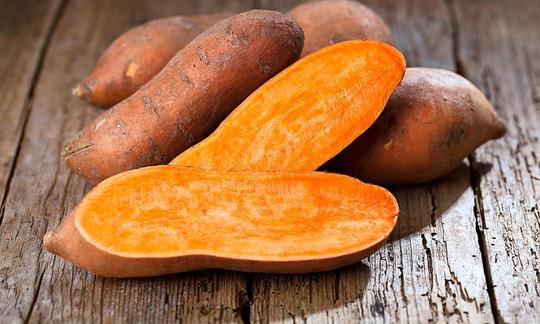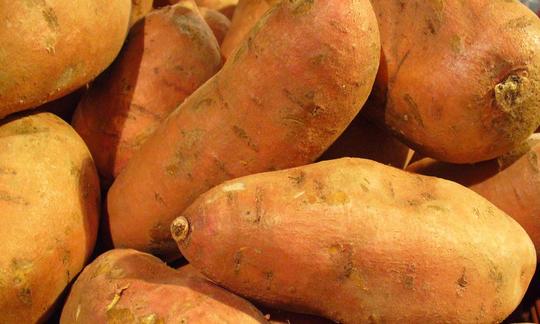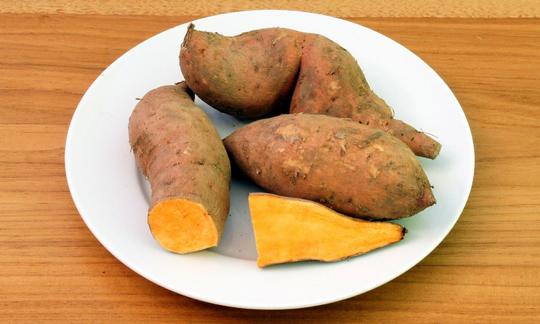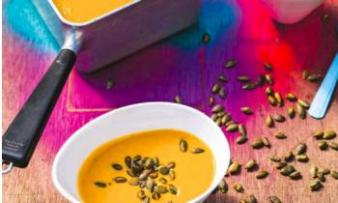Sweet potatoes (sweet potatoes, white potatoes) are not actually potatoes. Although they grow as tubers in the ground, unlike ordinary potatoes they are not part of the nightshade family but rather belong to the morning glory family. The leaves of the sweet potato are also edible and are used as food in tropical countries.
Use in the kitchen:
The storage root of the sweet potato is edible and varies in color between white, orange, pink and purple. In the kitchen, red-fleshed varieties of sweet potatoes are preferable. These have a particularly good aroma and are quickly cooked until soft. Sweet potatoes taste similar to potatoes, baked, deep-fried, gratinated or roasted. They also taste good in soup, in stews, as dal, in curries, grilled or simply steamed as a side dish.
In the USA, they are known baked as part of the traditional Thanksgiving turkey meal. In New Zealand, the other Pacific islands and also in Peru, sweet potatoes are known as kumara, where they are mainly fried and eaten as kumara fries. In Asia, especially Korea, there are also noodles made from sweet potatoes. These are served with the traditional japchae (vegetable dish), for example. In Japan, sweet potatoes are mainly used in desserts such as yōkan. Alcoholic drinks such as imojōchū in Japan and soju in Korea are also made from sweet potatoes. In Africa, the herb is prepared in a similar way to spinach and is often used as a side dish.
Can you eat sweet potatoes raw? Raw sweet potatoes are also edible and taste good, as long as you choose varieties with a low cyanide content.
| Not only vegans or vegetarians should read this: Vegans often eat unhealthily. Avoidable nutritional errors. |
Shopping:
Sweet potatoes can be found in many supermarkets. Organically produced ones are also available in well-stocked markets. They are usually not packaged at all or there are only a few in a package. Fresh tubers can be recognized by the fact that they are firm and not wrinkled, and you should also make sure that the skin is intact.
Storage:
It is advisable to always buy fresh sweet potatoes, as they do not last very long. However, if you need a larger supply, they can be kept raw for up to 6 months in a dark, dry place. It is important to remember that they should be stored at room temperature, e.g. in the pantry or in a dry cellar. Bruises should be avoided, which is why they can also be wrapped individually in newspaper. They last the longest when frozen, but always cooked or boiled - not raw, as otherwise they lose too much of their flavour.
Ingredients:
See the essential nutritional values in the tables below. Sweet potatoes, as the name suggests, taste very sweet, which is due to the high sugar content. The tuber also contains a lot of starch, vitamins and nutrients, especially vitamin C, B2, B6, E, biotin, manganese, folate, copper and iron. The inside of the storage root, as well as the skin, contain various carotenoids and anthocyanins, which is why the color can vary.
Some varieties contain detectable amounts of hydrogen cyanide, which is why variety-specific knowledge is required when eating them raw. When cooked, the hydrogen cyanide content is harmless. Sweet potatoes often contain increased levels of oxalic acid, but this is no longer present in the tuber after cooking, but is present in the cooking water.
Health aspects:
According to CSPI (Center for Science in the Public Interest), the sweet potato is the most nutrient-rich vegetable. Due to its antioxidant content, the sweet potato is said to have an anti-inflammatory effect, but also against problems that are caused by inflammation, such as asthma, arthritis, gout. Eating it with the skin on is effective against digestive problems due to the high fiber content, but also as a prevention against colon cancer. 6
Use as a medicinal plant:
Indigenous peoples (in Japan) who mainly eat sweet potatoes do not suffer from diabetes, anemia or high blood pressure - this has made researchers curious. One ingredient is responsible for this - Caiapo - which is mainly contained in the peel. When consumed regularly, blood sugar levels drop, blood volume increases and blood flow improves. 5
Occurrence:
Before 1492, when America was rediscovered, people are believed to have spread sweet potatoes from Peru to the Pacific islands. In addition, freed African slaves brought sweet potatoes from America to Africa. Today they are cultivated in the tropics, subtropics and temperate zones of the world. The People's Republic of China has the highest cultivation rate, but awareness and thus cultivation are also increasing within Europe, especially in Italy, Spain and Portugal.
Cultivation, harvest:
A sandy, permeable soil is best suited for growing sweet potatoes. To ensure nutrient-rich soil, it should be enriched with compost and horn shavings before planting. Cultivation in buckets or window boxes is also possible. Potting soil or a sand-compost mixture is also suitable as a substrate. 4
Sweet potatoes can be grown in three different ways. Propagation by seed is not very useful, as they are very difficult to germinate. The main method for propagation is to use shoot cuttings. The lowest leaves are removed from the 30 - 45 mm long cuttings and two thirds of the length is inserted into the substrate. 2 When using the storage roots as a propagation organ (similar to potatoes), you can either plant seed tubers from the store or your own seed tubers from the previous year. The temperature during cultivation must not fall below 10 °C, which is why pre-cultivation is best done indoors. If there is no longer any risk of frost in May, the tubers are ready for the garden. 4
Sweet potatoes need consistent moisture, which is especially important in dry summers. Mulching with compost or grass clippings prevents them from drying out. When growing sweet potatoes in buckets or boxes, please ensure that no waterlogging occurs, otherwise there is a risk of rot developing. 4
General information:
The sweet potato ( Ipomoea batatas) is also known as the sweet potato, white potato or tuberous morning glory. It is a crop and belongs to the morning glory family ( Convolvulaceae). With an annual harvest of 103 million tons, it is the third largest root and tuber crop in the world after potatoes ( Solanum tuberosum ) and cassava ( Manihot esculenta). The sweet potato is only distantly related to the potato ( Solanum tuberosum), which belongs to the nightshade family. Other common names are: Bataton, Pataten, Patatos and Potaten 2
Interesting facts:
The above-ground parts of the perennial herbaceous climbing plant can reach a length of up to 4 m, but usually lie creeping on the ground. Some varieties have no flowers, others have lavender to violet-colored flowers, which close again after a few hours, still in the morning, and begin to wilt. If the plant forms fruit, which happens very rarely, it only contains up to two black, round seeds (up to 3 mm). These germinate very hard, however. The seed coat is particularly hard and hardly any water or oxygen manages to penetrate it. The storage roots have a spherical to long spindle-shaped appearance and vary greatly in size (up to 30 cm long) and weight (up to several kg). 2
Studies show that sweet potatoes contain so-called transfer DNA (T-DNA) from the bacterium Agrobacterium, which means that they are naturally transgenic plants. This interaction between plants and bacteria must have taken place about 8,000 years ago and it shows research that gene transfer is not necessarily something unnatural. 1
Origin of the plant:
Heinz Brücher, long-time professor of plant genetics in South America, has discussed the name and origin of the sweet potato in detail and interestingly on pages 118-120 of his book "Tropical Crops". There is at least reliable evidence of its use by humans from excavations in Peru. It was immortalized there on ceramics in prehistoric times by the Mochica culture. This was before the Inca period. 7
However, if one looks for the gene center, the sweet potato probably originated in Asia and not in the Americas, as was thought for a very long time: the current fossil record suggests a North American origin, which is in contrast to molecular data pointing to an East Gondwana origin. We report Ipomoea leaves from the late Paleocene (Thanetian; 58.7-55.8 million years ago) of India, which was part of East Gondwana during this time. This is the earliest fossil record for both the family Convolvulaceae and the order Solanales. This suggests that the sister families Convolvulaceae and Solanaceae diverged in Gondwana-derived continents before the Eocene. The evidence presented here supports the conclusion from the molecular phylogenetic analysis of an East Gondwana origin of Convolvulaceae. 3
Literature / Sources:
- Kyndt T, Quispe D, Zhai H, Jarret R, Ghislain M, Liu Q et al. The genome of cultivated sweet potato contains Agrobacterium T-DNAs with expressed genes: An example of a naturally transgenic food crop. PNAS. 2015, April
- German Wikipedia. Sweet potato.
- Srivastava G, Mehrotra R, Dilcher D. Paleocene Ipomoea (Convolvulaceae) from India with implications for an East Gondwana origin of Convolvulaceae. PNAS. 2018, May.
- Garden encyclopedia. Planting sweet potatoes - growing and caring for sweet potatoes.
- Ludvik B, Neuffer B, Pacini G. Efficacy of Ipomoea batatas (Caiapo) on Diabetes Control in Type 2 Diabetic Subjects Treated With Diet. Diabetes Care. 2004, Feb; 27(2).
- Swiss homepage about sweet potatoes. suesskartoffel.ch
- Brücher, Heinz: Tropical crops (origin, evolution and domestication), Springer-Verlag, 1977















Comments